Page 57 of 97
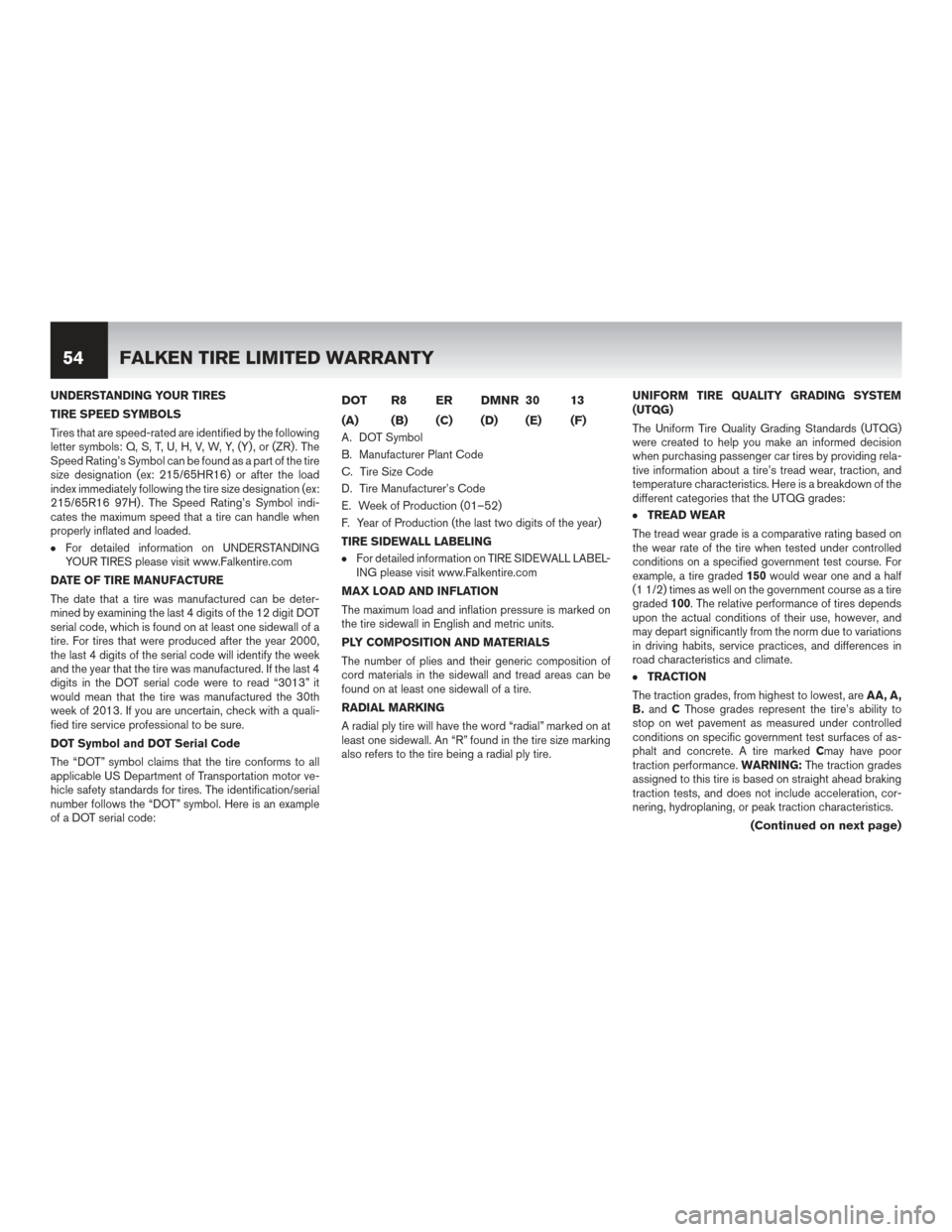
UNDERSTANDING YOUR TIRES
TIRE SPEED SYMBOLS
Tires that are speed-rated are identified by the following
letter symbols: Q, S, T, U, H, V, W, Y, (Y) , or (ZR) . The
Speed Rating’s Symbol can be found as a part of the tire
size designation (ex: 215/65HR16) or after the load
index immediately following the tire size designation (ex:
215/65R16 97H) . The Speed Rating’s Symbol indi-
cates the maximum speed that a tire can handle when
properly inflated and loaded.
●For detailed information on UNDERSTANDING
YOUR TIRES please visit www.Falkentire.com
DATE OF TIRE MANUFACTURE
The date that a tire was manufactured can be deter-
mined by examining the last 4 digits of the 12 digit DOT
serial code, which is found on at least one sidewall of a
tire. For tires that were produced after the year 2000,
the last 4 digits of the serial code will identify the week
and the year that the tire was manufactured. If the last 4
digits in the DOT serial code were to read “3013” it
would mean that the tire was manufactured the 30th
week of 2013. If you are uncertain, check with a quali-
fied tire service professional to be sure.
DOT Symbol and DOT Serial Code
The “DOT” symbol claims that the tire conforms to all
applicable US Department of Transportation motor ve-
hicle safety standards for tires. The identification/serial
number follows the “DOT” symbol. Here is an example
of a DOT serial code:
DOT R8 ER DMNR 30 13
(A) (B) (C) (D) (E) (F)
A. DOT Symbol
B. Manufacturer Plant Code
C. Tire Size Code
D. Tire Manufacturer’s Code
E. Week of Production (01–52)
F. Year of Production (the last two digits of the year)
TIRE SIDEWALL LABELING
●For detailed information on TIRE SIDEWALL LABEL-
ING please visit www.Falkentire.com
MAX LOAD AND INFLATION
The maximum load and inflation pressure is marked on
the tire sidewall in English and metric units.
PLY COMPOSITION AND MATERIALS
The number of plies and their generic composition of
cord materials in the sidewall and tread areas can be
found on at least one sidewall of a tire.
RADIAL MARKING
A radial ply tire will have the word “radial” marked on at
least one sidewall. An “R” found in the tire size marking
also refers to the tire being a radial ply tire. UNIFORM TIRE QUALITY GRADING SYSTEM
(UTQG)
The Uniform Tire Quality Grading Standards (UTQG)
were created to help you make an informed decision
when purchasing passenger car tires by providing rela-
tive information about a tire’s tread wear, traction, and
temperature characteristics. Here is a breakdown of the
different categories that the UTQG grades:
●TREAD WEAR
The tread wear grade is a comparative rating based on
the wear rate of the tire when tested under controlled
conditions on a specified government test course. For
example, a tire graded 150would wear one and a half
(1 1/2) times as well on the government course as a tire
graded 100. The relative performance of tires depends
upon the actual conditions of their use, however, and
may depart significantly from the norm due to variations
in driving habits, service practices, and differences in
road characteristics and climate.
●TRACTION
The traction grades, from highest to lowest, are AA, A,
B. and CThose grades represent the tire’s ability to
stop on wet pavement as measured under controlled
conditions on specific government test surfaces of as-
phalt and concrete. A tire marked Cmay have poor
traction performance. WARNING:The traction grades
assigned to this tire is based on straight ahead braking
traction tests, and does not include acceleration, cor-
nering, hydroplaning, or peak traction characteristics.
(Continued on next page)
54 FALKEN TIRE LIMITED WARRANTY
Page 58 of 97
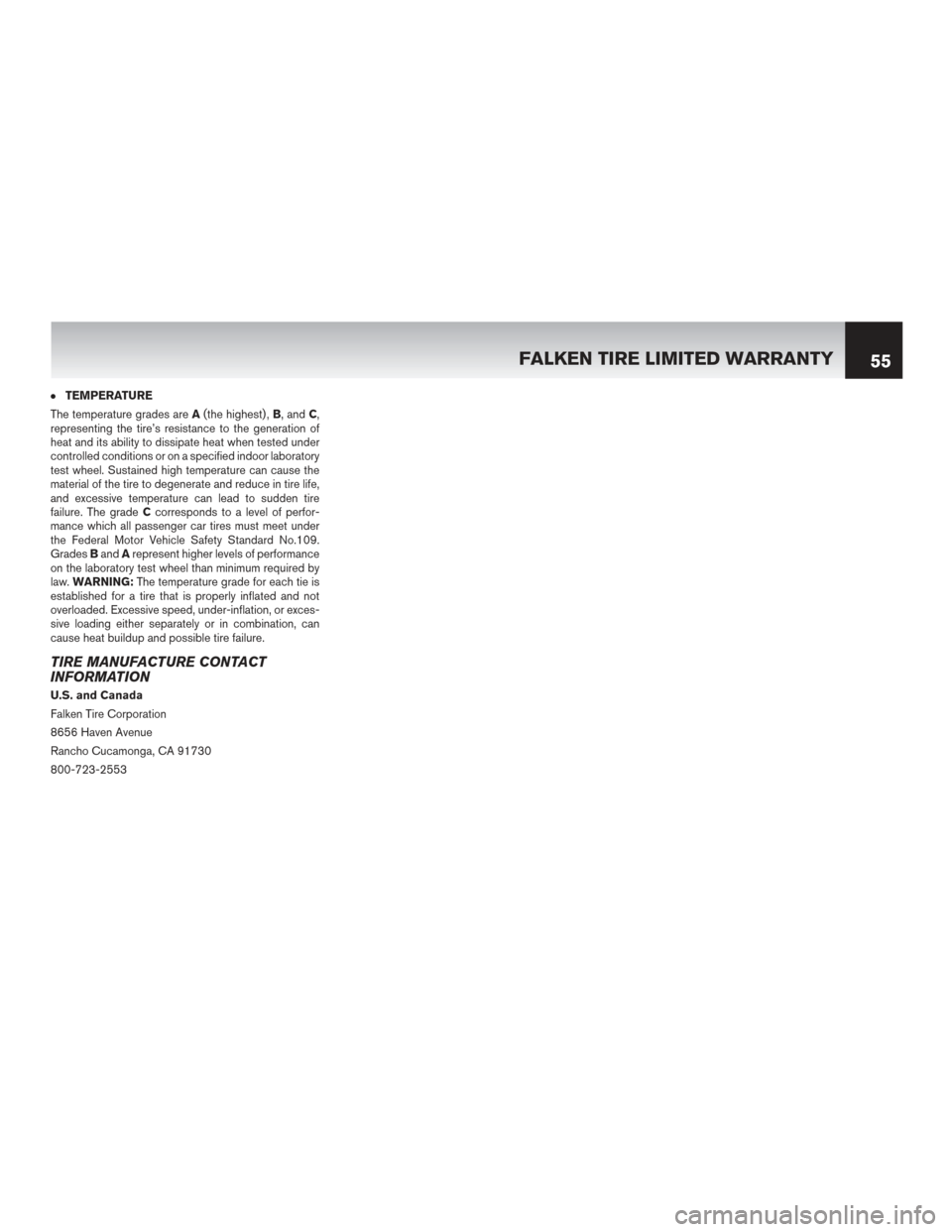
●TEMPERATURE
The temperature grades are A(the highest) , B, andC,
representing the tire’s resistance to the generation of
heat and its ability to dissipate heat when tested under
controlled conditions or on a specified indoor laboratory
test wheel. Sustained high temperature can cause the
material of the tire to degenerate and reduce in tire life,
and excessive temperature can lead to sudden tire
failure. The grade Ccorresponds to a level of perfor-
mance which all passenger car tires must meet under
the Federal Motor Vehicle Safety Standard No.109.
Grades Band Arepresent higher levels of performance
on the laboratory test wheel than minimum required by
law. WARNING: The temperature grade for each tie is
established for a tire that is properly inflated and not
overloaded. Excessive speed, under-inflation, or exces-
sive loading either separately or in combination, can
cause heat buildup and possible tire failure.
TIRE MANUFACTURE CONTACT
INFORMATION
U.S. and Canada
Falken Tire Corporation
8656 Haven Avenue
Rancho Cucamonga, CA 91730
800-723-2553
FALKEN TIRE LIMITED WARRANTY 55
Page 59 of 97
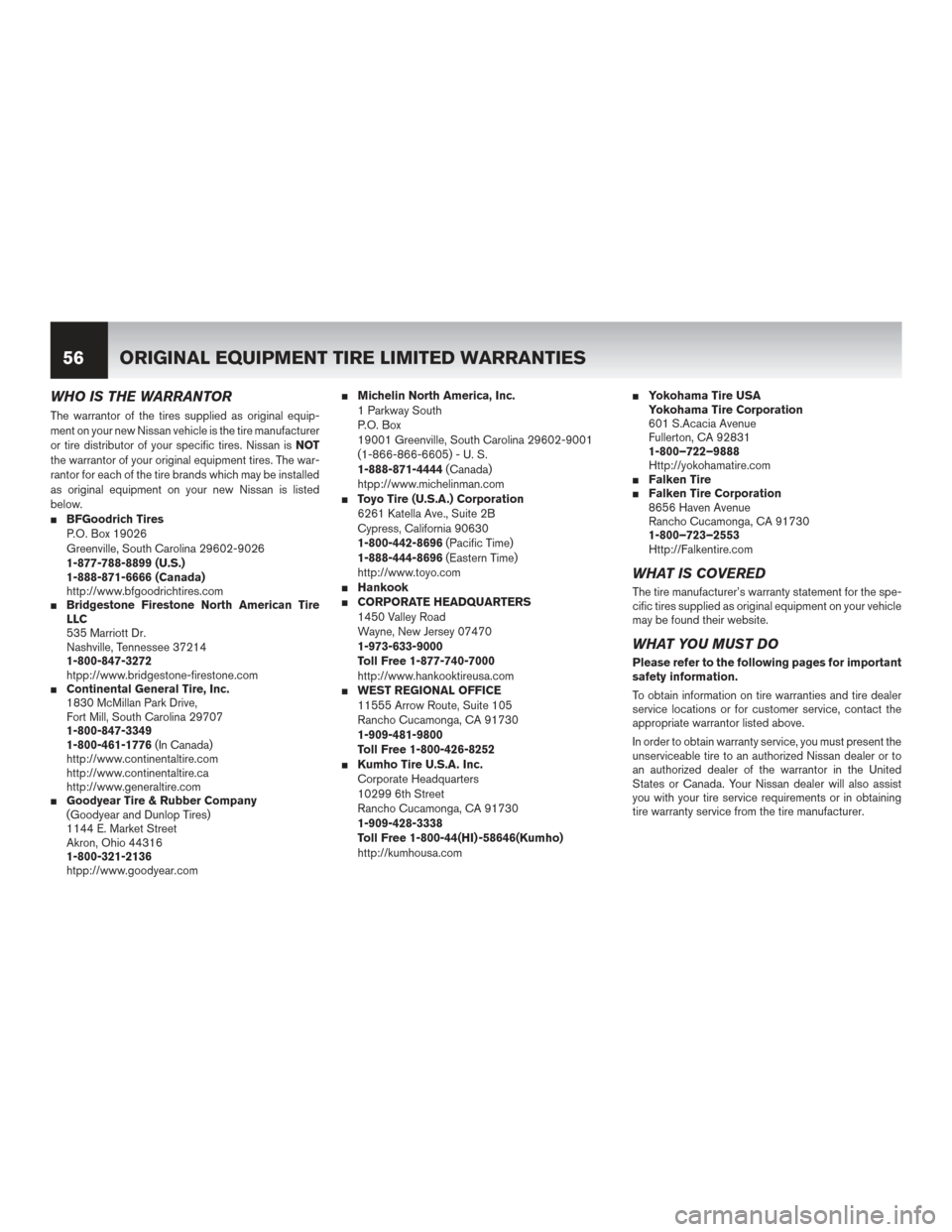
WHO IS THE WARRANTOR
The warrantor of the tires supplied as original equip-
ment on your new Nissan vehicle is the tire manufacturer
or tire distributor of your specific tires. Nissan isNOT
the warrantor of your original equipment tires. The war-
rantor for each of the tire brands which may be installed
as original equipment on your new Nissan is listed
below.
�BFGoodrich Tires
P.O. Box 19026
Greenville, South Carolina 29602-9026
1-877-788-8899 (U.S.)
1-888-871-6666 (Canada)
http://www.bfgoodrichtires.com
�Bridgestone Firestone North American Tire
LLC
535 Marriott Dr.
Nashville, Tennessee 37214
1-800-847-3272
htpp://www.bridgestone-firestone.com
�Continental General Tire, Inc.
1830 McMillan Park Drive,
Fort Mill, South Carolina 29707
1-800-847-3349
1-800-461-1776 (In Canada)
http://www.continentaltire.com
http://www.continentaltire.ca
http://www.generaltire.com
�Goodyear Tire & Rubber Company
(Goodyear and Dunlop Tires)
1144 E. Market Street
Akron, Ohio 44316
1-800-321-2136
htpp://www.goodyear.com
�Michelin North America, Inc.
1 Parkway South
P.O. Box
19001 Greenville, South Carolina 29602-9001
(1-866-866-6605) - U. S.
1-888-871-4444 (Canada)
htpp://www.michelinman.com
�Toyo Tire (U.S.A.) Corporation
6261 Katella Ave., Suite 2B
Cypress, California 90630
1-800-442-8696 (Pacific Time)
1-888-444-8696 (Eastern Time)
http://www.toyo.com
�Hankook�CORPORATE HEADQUARTERS
1450 Valley Road
Wayne, New Jersey 07470
1-973-633-9000
Toll Free 1-877-740-7000
http://www.hankooktireusa.com
�WEST REGIONAL OFFICE
11555 Arrow Route, Suite 105
Rancho Cucamonga, CA 91730
1-909-481-9800
Toll Free 1-800-426-8252
�Kumho Tire U.S.A. Inc.
Corporate Headquarters
10299 6th Street
Rancho Cucamonga, CA 91730
1-909-428-3338
Toll Free 1-800-44(HI) -58646(Kumho)
http://kumhousa.com
�Yokohama Tire USA
Yokohama Tire Corporation
601 S.Acacia Avenue
Fullerton, CA 92831
1-800–722–9888
Http://yokohamatire.com
�Falken Tire�Falken Tire Corporation
8656 Haven Avenue
Rancho Cucamonga, CA 91730
1-800–723–2553
Http://Falkentire.com
WHAT IS COVERED
The tire manufacturer’s warranty statement for the spe-
cific tires supplied as original equipment on your vehicle
may be found their website.
WHAT YOU MUST DO
Please refer to the following pages for important
safety information.
To obtain information on tire warranties and tire dealer
service locations or for customer service, contact the
appropriate warrantor listed above.
In order to obtain warranty service, you must present the
unserviceable tire to an authorized Nissan dealer or to
an authorized dealer of the warrantor in the United
States or Canada. Your Nissan dealer will also assist
you with your tire service requirements or in obtaining
tire warranty service from the tire manufacturer.
56 ORIGINAL EQUIPMENT TIRE LIMITED WARRANTIES
Page 60 of 97

Any tire, no matter how well constructed, may fail due to
improper maintenance or service factors. This could
create a risk of property damage and serious or fatal
injury. Disregarding any of the safety precautions and
instructions contained in this manual may result in tire
failure or explosion causing serious personal injury or
death. For your safety, comply with the following:
TIRE INFLATION
Keep tires inflated to the pressures recommended on
the tire data placard. (See your Owner’s Manual for
location.) These inflation pressures must be maintained
as a minimum. However, do not exceed the maximum
pressure rating indicated on the tire sidewall.
CHECK INFLATION PRESSURES ON ALL YOUR
TIRES, INCLUDING THE SPARE, WHEN TIRES ARE
COLD, AT LEAST ONCE A MONTH BEFORE DRIV-
ING.
Failure to maintain correct inflation may result in im-
proper vehicle handling and may cause rapid and ir-
regular tire wear, sudden tire destruction, loss of vehicle
control and serious personal injury. Therefore, inflation
pressures should be checked at least once a month and
always prior to long distance trips.
Pressures should be checked when tires are cold. The
tires are cold when your vehicle has been driven less
than a mile at moderate speed after being stopped for
three or more hours.
CHECKING PRESSURE WHEN TIRES
ARE HOT
If you must add air when your tires are hot, add four
pounds per square inch (psi) (28kPa) above the recom-
mended cold air pressure. Recheck the inflation pres-
sure when the tire is cold.
For Example Only:
Gauge reading of hot tire: 32psi
If recommended pressure is: 30psi
Desired gauge reading of hot tire 30 + 4psi = 34psi
Check cold pressures as soon as possible, at least by
the next day. Never “bleed” air from hot tires as your tire
will be underinflated. Use an accurate tire gauge to
check pressures. Never allow children to air up tires.
DRIVING ON ANY TIRE THAT DOES NOT HAVE THE
CORRECT INFLATION PRESSURE IS DANGEROUS.
For replacement tires, the correct inflation pressure will be
provided by your tire dealer. If not, refer to the vehicle decal.
Underinflation produces extreme flexing of the sidewalls
and builds up heat which may result in sudden tire de-
struction and serious personal injury. Overinflating can
cause the tire to be more susceptible to impact damage.
LOAD LIMITS
DO NOT OVERLOAD. DRIVING ON ANY OVER-
LOADED TIRE IS DANGEROUS.Never load your
tires beyond the load carrying limits molded into the
sidewall of the tires or the maximum vehicle load limit as
shown on the vehicle tire data placard, whichever is
less. Overloading causes heat to build up which can
lead to sudden tire failure and serious personal injury.
SPEED LIMITS AND SPEED RATED
TIRES
HIGH SPEED DRIVING CAN BE DANGEROUS.Never operate your vehicle in excess of lawful speeds or
the maximum speeds justified by the driving conditions.
Excessive speeds or racing can cause heat buildup in a
tire leading to possible failure and serious personal injury.
Correct inflation pressure is especially important.
However, at high speeds, even with the correct inflation
pressure, a road hazard, for example, is more difficult to
avoid and if contact is made, there is a greater chance of
causing tire damage than at the lower speed. Moreover,
driving at high speed reduces the reaction time available
to avoid accidents and bring your vehicle to a safe stop. If
you see any damage to a tire or wheel, replace it with your
spare tire and see your tire dealer at once.
Tire speed ratings do not imply that a vehicle can be
safely driven at the maximum speed for which the tire is
rated. In addition, some damages or improper repairs
may cause a speed-rated tire to lose its speed rating.
Exceeding the tire’s maximum speed rating will cause
the tire to build up excessive heat which can cause tire
damage that could result in sudden tire destruction and
rapid air loss. Failure to control a vehicle with sudden air
loss can lead to an accident. In any case, you should not
exceed reasonable speeds as indicated by the legal
limits and driving conditions.
(Continued on next page)
1 Provided by and published at the request of the tire manufacturers/warrantors.
IMPORTANT TIRE SAFETY INFORMATION157
Page 61 of 97
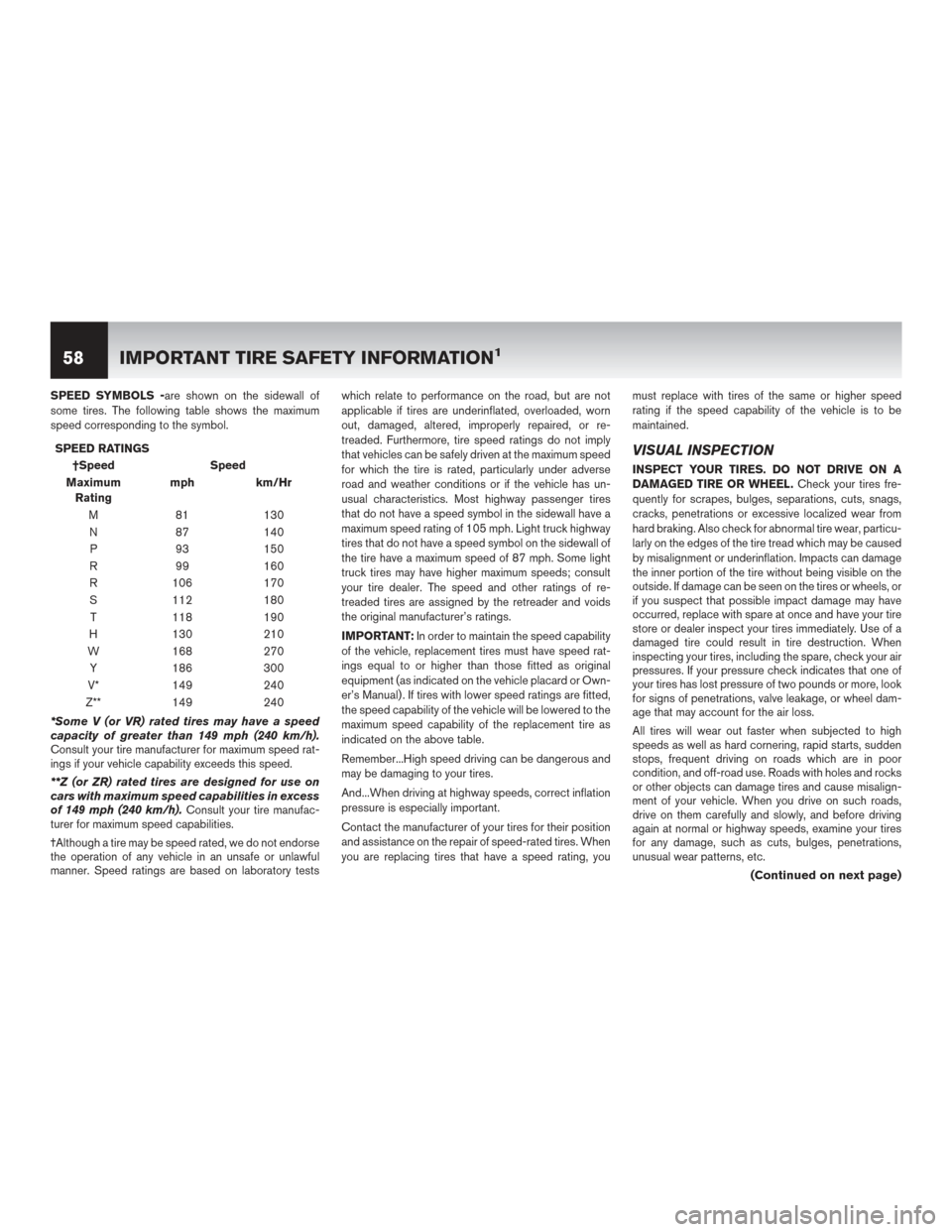
SPEED SYMBOLS -are shown on the sidewall of
some tires. The following table shows the maximum
speed corresponding to the symbol.SPEED RATINGS †Speed Speed
Maximum Rating mph km/Hr
M 81 130
N 87 140
P 93 150
R 99 160
R 106 170
S 112 180
T 118 190
H 130 210
W 168 270
Y 186 300
V* 149 240
Z** 149 240
*Some V (or VR) rated tires may have a speed
capacity of greater than 149 mph (240 km/h).
Consult your tire manufacturer for maximum speed rat-
ings if your vehicle capability exceeds this speed.
**Z (or ZR) rated tires are designed for use on
cars with maximum speed capabilities in excess
of 149 mph (240 km/h). Consult your tire manufac-
turer for maximum speed capabilities.
†Although a tire may be speed rated, we do not endorse
the operation of any vehicle in an unsafe or unlawful
manner. Speed ratings are based on laboratory tests which relate to performance on the road, but are not
applicable if tires are underinflated, overloaded, worn
out, damaged, altered, improperly repaired, or re-
treaded. Furthermore, tire speed ratings do not imply
that vehicles can be safely driven at the maximum speed
for which the tire is rated, particularly under adverse
road and weather conditions or if the vehicle has un-
usual characteristics. Most highway passenger tires
that do not have a speed symbol in the sidewall have a
maximum speed rating of 105 mph. Light truck highway
tires that do not have a speed symbol on the sidewall of
the tire have a maximum speed of 87 mph. Some light
truck tires may have higher maximum speeds; consult
your tire dealer. The speed and other ratings of re-
treaded tires are assigned by the retreader and voids
the original manufacturer’s ratings.
IMPORTANT:
In order to maintain the speed capability
of the vehicle, replacement tires must have speed rat-
ings equal to or higher than those fitted as original
equipment (as indicated on the vehicle placard or Own-
er’s Manual) . If tires with lower speed ratings are fitted,
the speed capability of the vehicle will be lowered to the
maximum speed capability of the replacement tire as
indicated on the above table.
Remember...High speed driving can be dangerous and
may be damaging to your tires.
And...When driving at highway speeds, correct inflation
pressure is especially important.
Contact the manufacturer of your tires for their position
and assistance on the repair of speed-rated tires. When
you are replacing tires that have a speed rating, you must replace with tires of the same or higher speed
rating if the speed capability of the vehicle is to be
maintained.
VISUAL INSPECTION
INSPECT YOUR TIRES. DO NOT DRIVE ON A
DAMAGED TIRE OR WHEEL.
Check your tires fre-
quently for scrapes, bulges, separations, cuts, snags,
cracks, penetrations or excessive localized wear from
hard braking. Also check for abnormal tire wear, particu-
larly on the edges of the tire tread which may be caused
by misalignment or underinflation. Impacts can damage
the inner portion of the tire without being visible on the
outside. If damage can be seen on the tires or wheels, or
if you suspect that possible impact damage may have
occurred, replace with spare at once and have your tire
store or dealer inspect your tires immediately. Use of a
damaged tire could result in tire destruction. When
inspecting your tires, including the spare, check your air
pressures. If your pressure check indicates that one of
your tires has lost pressure of two pounds or more, look
for signs of penetrations, valve leakage, or wheel dam-
age that may account for the air loss.
All tires will wear out faster when subjected to high
speeds as well as hard cornering, rapid starts, sudden
stops, frequent driving on roads which are in poor
condition, and off-road use. Roads with holes and rocks
or other objects can damage tires and cause misalign-
ment of your vehicle. When you drive on such roads,
drive on them carefully and slowly, and before driving
again at normal or highway speeds, examine your tires
for any damage, such as cuts, bulges, penetrations,
unusual wear patterns, etc.
(Continued on next page)
58 IMPORTANT TIRE SAFETY INFORMATION1
Page 62 of 97
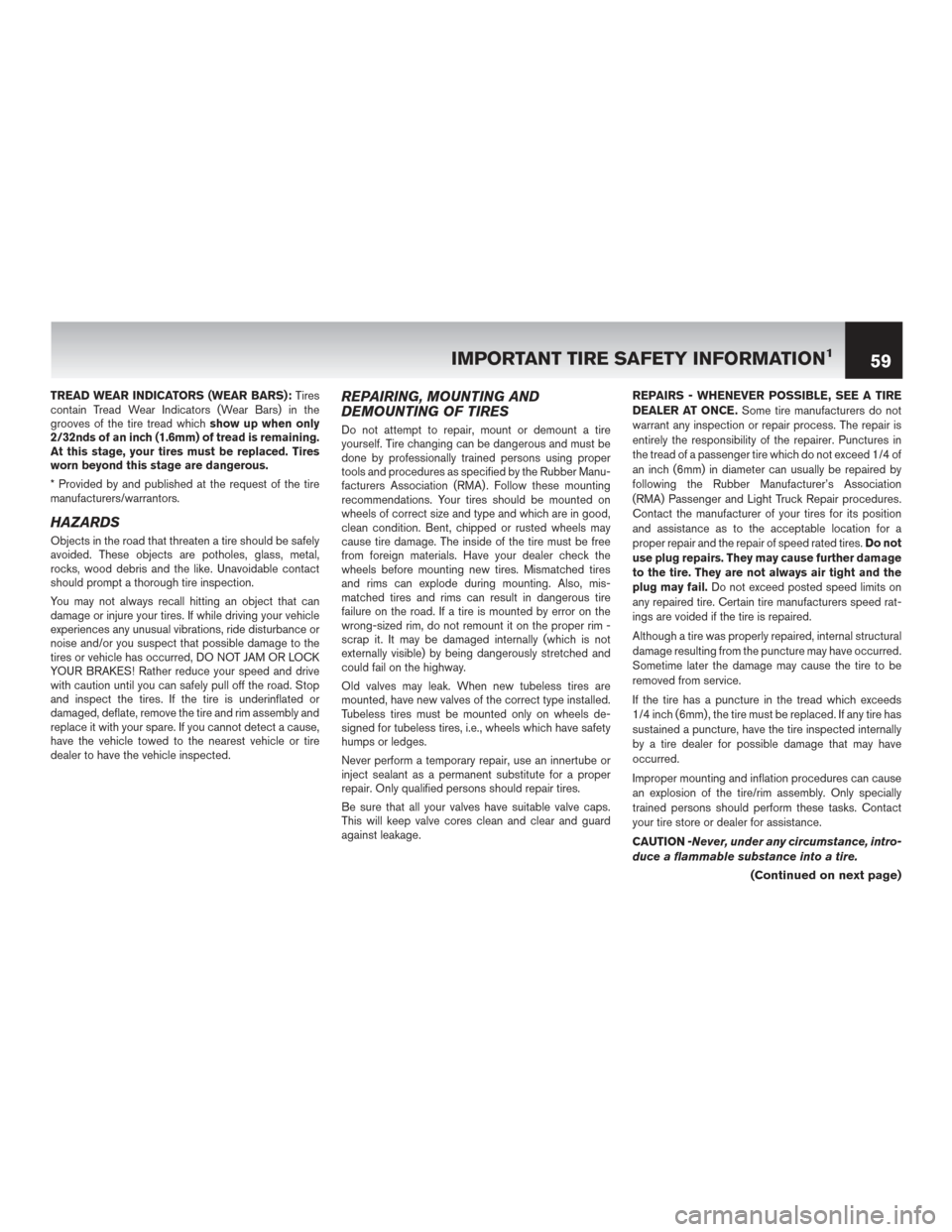
TREAD WEAR INDICATORS (WEAR BARS):Tires
contain Tread Wear Indicators (Wear Bars) in the
grooves of the tire tread which show up when only
2/32nds of an inch (1.6mm) of tread is remaining.
At this stage, your tires must be replaced. Tires
worn beyond this stage are dangerous.
* Provided by and published at the request of the tire
manufacturers/warrantors.
HAZARDS
Objects in the road that threaten a tire should be safely
avoided. These objects are potholes, glass, metal,
rocks, wood debris and the like. Unavoidable contact
should prompt a thorough tire inspection.
You may not always recall hitting an object that can
damage or injure your tires. If while driving your vehicle
experiences any unusual vibrations, ride disturbance or
noise and/or you suspect that possible damage to the
tires or vehicle has occurred, DO NOT JAM OR LOCK
YOUR BRAKES! Rather reduce your speed and drive
with caution until you can safely pull off the road. Stop
and inspect the tires. If the tire is underinflated or
damaged, deflate, remove the tire and rim assembly and
replace it with your spare. If you cannot detect a cause,
have the vehicle towed to the nearest vehicle or tire
dealer to have the vehicle inspected.
REPAIRING, MOUNTING AND
DEMOUNTING OF TIRES
Do not attempt to repair, mount or demount a tire
yourself. Tire changing can be dangerous and must be
done by professionally trained persons using proper
tools and procedures as specified by the Rubber Manu-
facturers Association (RMA) . Follow these mounting
recommendations. Your tires should be mounted on
wheels of correct size and type and which are in good,
clean condition. Bent, chipped or rusted wheels may
cause tire damage. The inside of the tire must be free
from foreign materials. Have your dealer check the
wheels before mounting new tires. Mismatched tires
and rims can explode during mounting. Also, mis-
matched tires and rims can result in dangerous tire
failure on the road. If a tire is mounted by error on the
wrong-sized rim, do not remount it on the proper rim -
scrap it. It may be damaged internally (which is not
externally visible) by being dangerously stretched and
could fail on the highway.
Old valves may leak. When new tubeless tires are
mounted, have new valves of the correct type installed.
Tubeless tires must be mounted only on wheels de-
signed for tubeless tires, i.e., wheels which have safety
humps or ledges.
Never perform a temporary repair, use an innertube or
inject sealant as a permanent substitute for a proper
repair. Only qualified persons should repair tires.
Be sure that all your valves have suitable valve caps.
This will keep valve cores clean and clear and guard
against leakage. REPAIRS - WHENEVER POSSIBLE, SEE A TIRE
DEALER AT ONCE.
Some tire manufacturers do not
warrant any inspection or repair process. The repair is
entirely the responsibility of the repairer. Punctures in
the tread of a passenger tire which do not exceed 1/4 of
an inch (6mm) in diameter can usually be repaired by
following the Rubber Manufacturer’s Association
(RMA) Passenger and Light Truck Repair procedures.
Contact the manufacturer of your tires for its position
and assistance as to the acceptable location for a
proper repair and the repair of speed rated tires. Do not
use plug repairs. They may cause further damage
to the tire. They are not always air tight and the
plug may fail. Do not exceed posted speed limits on
any repaired tire. Certain tire manufacturers speed rat-
ings are voided if the tire is repaired.
Although a tire was properly repaired, internal structural
damage resulting from the puncture may have occurred.
Sometime later the damage may cause the tire to be
removed from service.
If the tire has a puncture in the tread which exceeds
1/4 inch (6mm) , the tire must be replaced. If any tire has
sustained a puncture, have the tire inspected internally
by a tire dealer for possible damage that may have
occurred.
Improper mounting and inflation procedures can cause
an explosion of the tire/rim assembly. Only specially
trained persons should perform these tasks. Contact
your tire store or dealer for assistance.
CAUTION -Never, under any circumstance, intro-
duce a flammable substance into a tire.
(Continued on next page)
IMPORTANT TIRE SAFETY INFORMATION159
Page 63 of 97
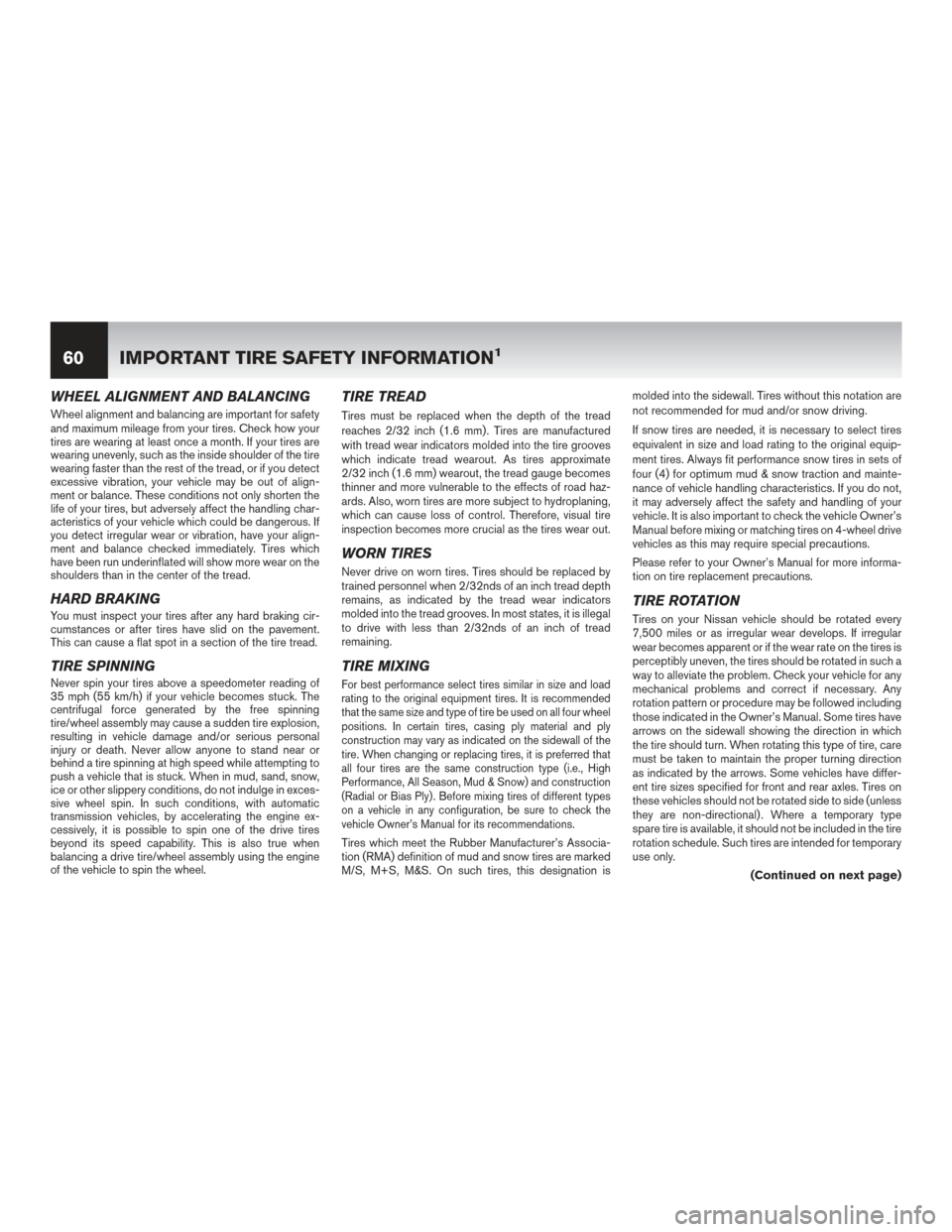
WHEEL ALIGNMENT AND BALANCING
Wheel alignment and balancing are important for safety
and maximum mileage from your tires. Check how your
tires are wearing at least once a month. If your tires are
wearing unevenly, such as the inside shoulder of the tire
wearing faster than the rest of the tread, or if you detect
excessive vibration, your vehicle may be out of align-
ment or balance. These conditions not only shorten the
life of your tires, but adversely affect the handling char-
acteristics of your vehicle which could be dangerous. If
you detect irregular wear or vibration, have your align-
ment and balance checked immediately. Tires which
have been run underinflated will show more wear on the
shoulders than in the center of the tread.
HARD BRAKING
You must inspect your tires after any hard braking cir-
cumstances or after tires have slid on the pavement.
This can cause a flat spot in a section of the tire tread.
TIRE SPINNING
Never spin your tires above a speedometer reading of
35 mph (55 km/h) if your vehicle becomes stuck. The
centrifugal force generated by the free spinning
tire/wheel assembly may cause a sudden tire explosion,
resulting in vehicle damage and/or serious personal
injury or death. Never allow anyone to stand near or
behind a tire spinning at high speed while attempting to
push a vehicle that is stuck. When in mud, sand, snow,
ice or other slippery conditions, do not indulge in exces-
sive wheel spin. In such conditions, with automatic
transmission vehicles, by accelerating the engine ex-
cessively, it is possible to spin one of the drive tires
beyond its speed capability. This is also true when
balancing a drive tire/wheel assembly using the engine
of the vehicle to spin the wheel.
TIRE TREAD
Tires must be replaced when the depth of the tread
reaches 2/32 inch (1.6 mm) . Tires are manufactured
with tread wear indicators molded into the tire grooves
which indicate tread wearout. As tires approximate
2/32 inch (1.6 mm) wearout, the tread gauge becomes
thinner and more vulnerable to the effects of road haz-
ards. Also, worn tires are more subject to hydroplaning,
which can cause loss of control. Therefore, visual tire
inspection becomes more crucial as the tires wear out.
WORN TIRES
Never drive on worn tires. Tires should be replaced by
trained personnel when 2/32nds of an inch tread depth
remains, as indicated by the tread wear indicators
molded into the tread grooves. In most states, it is illegal
to drive with less than 2/32nds of an inch of tread
remaining.
TIRE MIXING
For best performance select tires similar in size and load
rating to the original equipment tires. It is recommended
that the same size and type of tire be used on all four wheel
positions. In certain tires, casing ply material and ply
construction may vary as indicated on the sidewall of the
tire. When changing or replacing tires, it is preferred that
all four tires are the same construction type (i.e., High
Performance, All Season, Mud & Snow) and construction
(Radial or Bias Ply) . Before mixing tires of different types
on a vehicle in any configuration, be sure to check the
vehicle Owner’s Manual for its recommendations.
Tires which meet the Rubber Manufacturer’s Associa-
tion (RMA) definition of mud and snow tires are marked
M/S, M+S, M&S. On such tires, this designation ismolded into the sidewall. Tires without this notation are
not recommended for mud and/or snow driving.
If snow tires are needed, it is necessary to select tires
equivalent in size and load rating to the original equip-
ment tires. Always fit performance snow tires in sets of
four (4) for optimum mud & snow traction and mainte-
nance of vehicle handling characteristics. If you do not,
it may adversely affect the safety and handling of your
vehicle. It is also important to check the vehicle Owner’s
Manual before mixing or matching tires on 4-wheel drive
vehicles as this may require special precautions.
Please refer to your Owner’s Manual for more informa-
tion on tire replacement precautions.
TIRE ROTATION
Tires on your Nissan vehicle should be rotated every
7,500 miles or as irregular wear develops. If irregular
wear becomes apparent or if the wear rate on the tires is
perceptibly uneven, the tires should be rotated in such a
way to alleviate the problem. Check your vehicle for any
mechanical problems and correct if necessary. Any
rotation pattern or procedure may be followed including
those indicated in the Owner’s Manual. Some tires have
arrows on the sidewall showing the direction in which
the tire should turn. When rotating this type of tire, care
must be taken to maintain the proper turning direction
as indicated by the arrows. Some vehicles have differ-
ent tire sizes specified for front and rear axles. Tires on
these vehicles should not be rotated side to side (unless
they are non-directional) . Where a temporary type
spare tire is available, it should not be included in the tire
rotation schedule. Such tires are intended for temporary
use only.
(Continued on next page)
60
IMPORTANT TIRE SAFETY INFORMATION1
Page 64 of 97
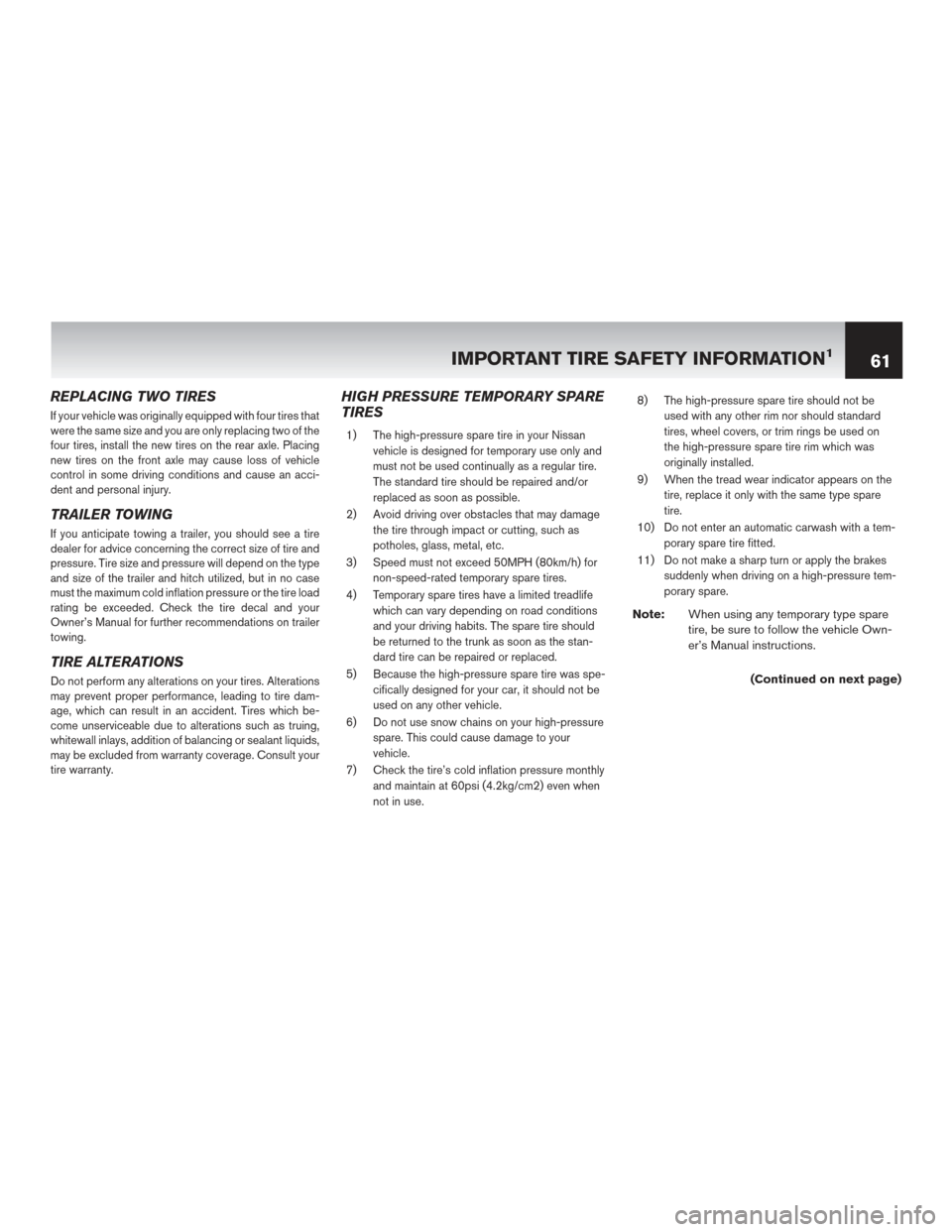
REPLACING TWO TIRES
If your vehicle was originally equipped with four tires that
were the same size and you are only replacing two of the
four tires, install the new tires on the rear axle. Placing
new tires on the front axle may cause loss of vehicle
control in some driving conditions and cause an acci-
dent and personal injury.
TRAILER TOWING
If you anticipate towing a trailer, you should see a tire
dealer for advice concerning the correct size of tire and
pressure. Tire size and pressure will depend on the type
and size of the trailer and hitch utilized, but in no case
must the maximum cold inflation pressure or the tire load
rating be exceeded. Check the tire decal and your
Owner’s Manual for further recommendations on trailer
towing.
TIRE ALTERATIONS
Do not perform any alterations on your tires. Alterations
may prevent proper performance, leading to tire dam-
age, which can result in an accident. Tires which be-
come unserviceable due to alterations such as truing,
whitewall inlays, addition of balancing or sealant liquids,
may be excluded from warranty coverage. Consult your
tire warranty.
HIGH PRESSURE TEMPORARY SPARE
TIRES
1) The high-pressure spare tire in your Nissanvehicle is designed for temporary use only and
must not be used continually as a regular tire.
The standard tire should be repaired and/or
replaced as soon as possible.
2) Avoid driving over obstacles that may damage the tire through impact or cutting, such as
potholes, glass, metal, etc.
3) Speed must not exceed 50MPH (80km/h) for non-speed-rated temporary spare tires.
4) Temporary spare tires have a limited treadlife which can vary depending on road conditions
and your driving habits. The spare tire should
be returned to the trunk as soon as the stan-
dard tire can be repaired or replaced.
5) Because the high-pressure spare tire was spe- cifically designed for your car, it should not be
used on any other vehicle.
6) Do not use snow chains on your high-pressure spare. This could cause damage to your
vehicle.
7) Check the tire’s cold inflation pressure monthly and maintain at 60psi (4.2kg/cm2) even when
not in use. 8) The high-pressure spare tire should not be
used with any other rim nor should standard
tires, wheel covers, or trim rings be used on
the high-pressure spare tire rim which was
originally installed.
9) When the tread wear indicator appears on the tire, replace it only with the same type spare
tire.
10) Do not enter an automatic carwash with a tem- porary spare tire fitted.
11) Do not make a sharp turn or apply the brakes suddenly when driving on a high-pressure tem-
porary spare.
Note: When using any temporary type spare
tire, be sure to follow the vehicle Own-
er’s Manual instructions.
(Continued on next page)
IMPORTANT TIRE SAFETY INFORMATION161